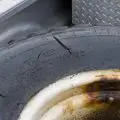Hey! This site is reader-supported and we earn commissions if you purchase products from retailers after clicking on a link from our site.
Your Guide to the Ins and Outs of Electrical Steps
To be painfully honest with you folks, I’m not a big fan of automated electrical RV entrance steps. I can say the same thing for power windows and door locks. For me, I find some of this advanced technology on RVs and vehicles to be excessive, expensive, and time consuming to repair and maintain.
For example, power windows in your tow vehicle or motorhome will eventually fail. Most likely, it will begin with blown fuses and end with a broken armature or broken teeth on the gears of the electric motors which will prevent the window from going up or down properly. Then the door panel must be removed, and you’ll have to evaluate numerous options to determine what the issue is and how to fix the problem. To me, I’d much rather spend an afternoon going fishing than I would fixing a window that could have just as well come with the traditional crank down type of window that are far less likely to have mechanical issues over the long run.
While I prefer the type of steps that are on my 5th wheel and I must reach under them and pull them out manually, I have in the past repaired automated steps for other RVers. Once you understand the mechanics of them it’s relatively easy to replace or in some cases repair the inoperable components of the steps.
Repairing your step
First check your power supply and switches. If you try to deploy your steps with the door open using the indoor switch, do they go down? If not, can you hear any noise when you activate the switch?
If you can, it’s likely to be either a humming sound or a clicking sound. Neither one of them is good news so shut the switch off immediately as it’s likely you’ll need to replace the whole assembly.
Alternatively, no sound would probably indicate that your motor is not getting power and you should check the switches and wiring harnesses for any shorts or faulty connections. I recommend using a good multimeter from your RV Tool Kit.
- 【More Versatile than Expected】MS8233D multimeter can accurately measure DC/AC voltage, DC/AC...
- 【User and Device Protection】The digital multimeter conforms to IEC61010-1 CAT III 600V safety...
- 【6000-Count LCD Screen】Equipped with a 6000-count (3 5/6 digits) LCD display, the multimeter...
Last update on 2025-06-14 / Affiliate links / Images from Amazon Product Advertising API
If you do need to remove the motor or any of the mechanical components, then I would highly recommend having a spray lubricant such as WD-40 on hand. Over time, road grime and weather take their toll on the bolts that secure the motor to the step assembly so you should lubricate them and wait a 10-15 minutes before you try to remove them.
- DRIVES OUT MOISTURE: Drives out moisture and quickly dries out electrical systems to eliminate...
- CORROSION INHIBITOR: Acts as a corrosion inhibitor to shield against moisture and other corrosive...
- FREES AND LOOSENS STICKY PARTS: Frees sticky mechanisms, loosens rust-to-metal bonds and helps...
Last update on 2025-06-14 / Affiliate links / Images from Amazon Product Advertising API
If your step is making a clicking sound while trying to deploy or retract, it’s likely that there are some teeth missing or broken in its linkage box. However, if there are broken gear teeth within the linkage box, they will often cause the gear to not turn at all and this will cause the motor to hum. When an electric motor hums, it means its bushings are not turning and it will quickly overheat and seize up permanently. Immediately turn the motor off if you hear this sound.
Shown here is the Kwikee® 379160 Gear Box Linkage with an “A” on its armature. These are made by Lippert Components and are suitable for replacement in step series 22, 23, 28A, 30, 32, 33, 34, 35, 36, 38 and 40.
- For step series 22, 23, 28A, 30, 32, 33, 34, 35, 36, 38 and 40. This gear box has a curved linkage...
- "A" is embossed on the linkage arm
- Gear box linkage for "a"
Last update on 2025-06-14 / Affiliate links / Images from Amazon Product Advertising API
Mechanically, this part is less likely to fail first as it’s usually an electrical system issue or a step motor failure. In the example shown here, the motor has already been removed. I recommend removing the motor from gearbox and if you’re sure the wiring is working correctly, plug the motor into the wiring harness and turn of the power to the motor. If the motor turns freely then there’s probably a problem associated with your gear box and you should now give that a good inspection too.
Some of these conversion kits can easily be installed in your rig, while others will need some adjustments.
- AUTOMATION — Kwikee steps automatically extend and retract when your RV's entryways door is opened...
- NIGHT OPERATION — A hidden light will illuminate for safer nighttime use
- ADDED SAFETY — Steps will automatically retract if an obstacle is detected near your stairs
Last update on 2025-06-14 / Affiliate links / Images from Amazon Product Advertising API
The positive side of replacing your automated step system using a replacement kit, is that all the components are of the same age. Too often when taking on these type of projects, I’ve found that if you replace a motor without a new gearbox, that a newer motor has more torque because it has lesser age and wear and it’s far more likely to damage an older gearbox within a few months of time. With that said, it’s in your best interest to replace the motor and gear box at the same time when servicing your automated steps. The same can be said for electrical components such as wiring harnesses and switches and of course its hardware.
Final thoughts
Frankly my fellow RVers, I would be unlikely to repair or replace an automated RV step system. Instead, I would look to replace it with a manually pull-out step that locks in place while I’m camping or on the road and is easily added to my RV departure checklist while I’m traveling.
With that said, thanks for following my columns, and as always…I hope to see you out on the road and enjoying our roadways. Whether they’re the two-lane byways that made America, or the Interstate Highways that hold our country together these days, I’ll be traveling them. I hope you folks will be too. Stay safe, stay healthy, and I hope to see you out on the road someday.









